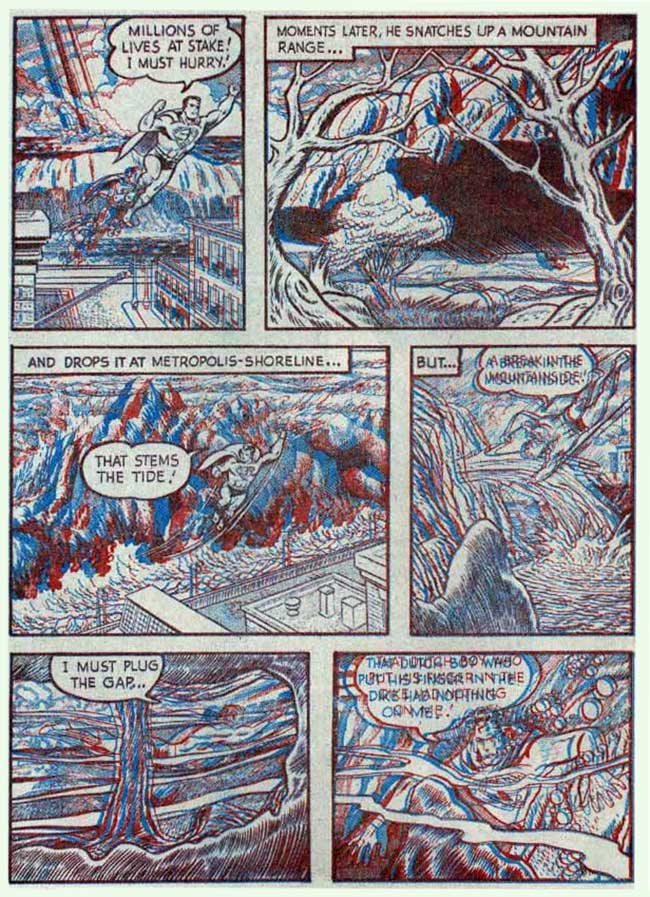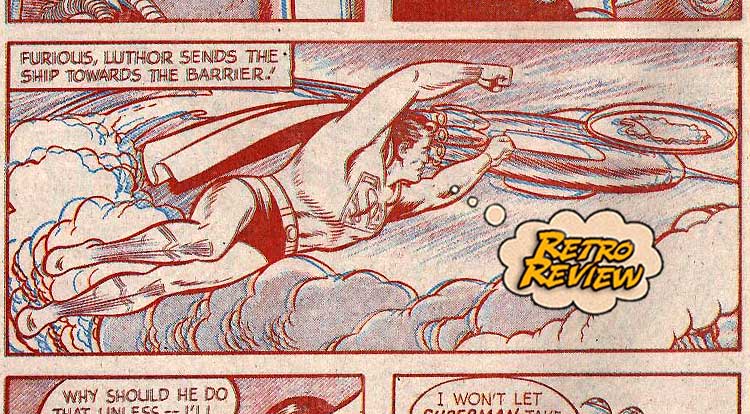If you think that gimmick covers and comics tying into the latest fads are a modern invention, you probably don’t know about the time that the 3-D craze sweeping the nation actually got top billing over the Man of Steel! Your Major Spoilers (Retro) Review of Three-Dimension Adventures Superman awaits!
 THREE-DIMENSION ADVENTURES SUPERMAN
THREE-DIMENSION ADVENTURES SUPERMAN
Writer: Jerry Siegel/Bill Finger
Penciler: Curt Swan/Wayne Boring
Inker: Al Plastino/Stan Kaye
Colorist: Jack Adler (Two-Tone Red & Blue 3-D)
Editor: Uncredited
Publisher: DC Comics
Cover Price: 25 Cents
Current Near-Mint Pricing: $1,400.00
Previously in Three-Dimension Adventures Superman: In an era where the ascendence of TV (and, not coincidentally, a loss of creative talent due to McCarthyism) was damaging movie box offices, producers were desperate to find anything to get people back into the theaters. Probably the most successful was 3-D film-making, using special stereoscopic cameras to trick the mind into creating an illusion of depth perception, and by 1953, it was sweeping the nation, though it soon proved to be an expensive flash-in-the-pan for movie theaters. In the world of comics publishing, however, it was a much less expensive flash-in-the-pan…

This gorgeous splash page, penciled by a young Curt Swan and almost certainly inked by Al Plastino or someone stealing his style, is the perfect example of how the stereoscopic 3-D printing process works: Color separations man Jack Adler would create multiple acetate cels of the art, arraying them in a way to creates the illusion of depth. (According to Adler, he reverse-engineered the DC version of the process, but none other than Joe Kubert himself, with his partner Norman Maurer, patented their “3-D Illustereo” process with the intention of licensing it to other publishers.) By wearing the special red/blue lenses, the image is filtered blah blah blah magic! As for our story itself, as you can tell if you squint very hard, it’s all about Lex Luthor… and he’s stolen the SUN!!!

I’m honestly in awe of how powerful Three-Dimension Adventures Superman, under the pen of creator Jerry Siegel actually is. When it becomes clear that the villain has stolen the sun, he takes a few moments to create a perfect underground city to house the denizens of Metropolis, only to see it destroyed by a massive heat ray from space! The page above shows him single-handedly stopping a tidal wave (!!) by picking up a massive mountain range and throwing it into Metropolis harbor (!!!) to stop the tsunami cold. Confronting Luthor, Superman manages to accidentally allow an opening for Lois Lane to sneak into the villain’s rocket-ship. The Man of Steel discovers the unbreakable force-field that Lex has used to “steal” the sun, and busts through it with sheer muscular force of will, smashing the giant lens that creates the heat ray. As Luthor tries to make his escape, we get a right and proper super-punch…

Lex is probably dead after that shot, by the way. As the story comes to a close, we find all is right with the world, with a little ironic echo that the weather is so hot in Metropolis that people start wishing the sun would disappear. It’s a cute little story, but it’s the art that really makes is sing for me, with the Swan/Plastino team delivering some really impressive visuals to go with Siegel’s belief that Superman has no limitations to his powers. This tale originally appeared in 1947, in Superman #48, while our second feature comes from #53, revisiting the destruction of Kal-El’s home planet, with an interesting Atomic-era twist…

THE CORE OF KRYPTON IS COMPOSED OF URANIUM!!!! Bill Finger’s use of super-powers is a bit more restrained than Siegel’s in the opening panels of this tale, and there are a lot of added bits of texture to the story, including the Kents discovering baby Kal, delivering him to an orphanage where they almost immediately begin the process of adopting the “abandoned” child. Baby Clark wrecks the orphanage, gets adopted, grows to young adulthood (no Superboy career here, as his youthful adventures didn’t start until 1949, and this story comes from the year previous) and ends with the death of the Kents and Clark’s promise to devote his life to justice in their name, so now I have to stop complaining about modern comics biting Batman’s motivations. Swan is back on pencils for our final tale, “The Man Who Bossed Superman”, writer unknown…

Racketeer Pudge Purdy wins a contest (proceeds to innocent orphans) wherein Superman must obey his every order for one day, like that Brady Bunch episode where Greg made Peter his servant after saving his brother’s life… That’s one wholesome message, you guys. Superman puts one over on the criminal, but since he doesn’t lift the entire sky and move solar systems by exhaling, it’s probably not a Siegel script. Featuring a well-curated set of reprints, Three-Dimension Adventures Superman is an awkwardly named, well-drawn, fascinating to look at comic book, even if you don’t have 3-D glasses (but you will probably get a headache without ’em), earning 3.5 out of 5 stars overall. The 3-D craze had mostly died out by the end of 1954 (in comics and movies alike) but these original books make really cool souvenirs of the long-lost gimmick, and I could literally sit and examine the actual 3-D process for hours…
[taq_review]Dear Spoilerite,
At Major Spoilers, we strive to create original content that you find interesting and entertaining. Producing, writing, recording, editing, and researching requires significant resources. We pay writers, podcast hosts, and other staff members who work tirelessly to provide you with insights into the comic book, gaming, and pop culture industries. Help us keep MajorSpoilers.com strong. Become a Patron (and our superhero) today.



1 Comment
Interesting detail : In THIS origin Kents are named Jonathan and Martha, instead of John and Mary. YET….!: there is still no Superboy. Jor-El also wears costume of his Earth-1 self rather than Bill Finger version (who’s origin really is some middle edge between Siegel and Binder one, not really Earth-2 and not Earth-1 yet either). Also unlike Finger’s 53 origin nobody on THIS Krypton mention that they have x-ray vision, unlike Finger’s actual origin where they aren’t powerful physically like in Siegel’s but mention they have x-ray unlike “primitives” of Earth.
I’d argue about Finger restraint. Siegel’s Superman traveled through time in a sophisticated way of going around some space, while Finger was the one that pioneered going through the straight line.